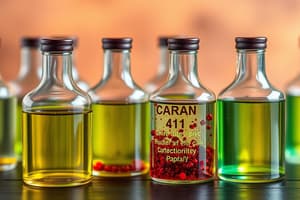Podcast
Questions and Answers
What is the primary reason that an atom will tend to bond with other elements?
What is the primary reason that an atom will tend to bond with other elements?
- To decrease the energy of the atom
- To increase the number of protons
- To form stable isotopes
- To completely fill its outer shell (correct)
Which elements are exclusively found in the first row of the periodic table?
Which elements are exclusively found in the first row of the periodic table?
- Hydrogen and lithium
- Helium and neon
- Lithium and neon
- Hydrogen and helium (correct)
How do sodium and chlorine ions achieve stability?
How do sodium and chlorine ions achieve stability?
- By increasing atomic mass
- By adding neutrons
- By forming covalent bonds
- By transferring electrons (correct)
What differentiates covalent bonds from ionic bonds?
What differentiates covalent bonds from ionic bonds?
Which statement accurately describes the octet rule?
Which statement accurately describes the octet rule?
What is the primary reason that carbon-14 can be used for dating once-living objects?
What is the primary reason that carbon-14 can be used for dating once-living objects?
Which statement accurately describes isotopes?
Which statement accurately describes isotopes?
What characterizes a radioactive isotope?
What characterizes a radioactive isotope?
What does the half-life of an isotope refer to?
What does the half-life of an isotope refer to?
How does the formation of 14C occur in the atmosphere?
How does the formation of 14C occur in the atmosphere?
Flashcards are hidden until you start studying
Study Notes
Isotopes
- Isotopes are variants of elements with the same number of protons but different numbers of neutrons.
- Naturally occurring isotopes include carbon, potassium, and uranium.
- Carbon-12 has six protons and six neutrons (mass number 12), with an atomic number of 6.
- Carbon-14 has six protons and eight neutrons (mass number 14), also with an atomic number of 6.
- Some isotopes are radioactive, meaning they decay to form stable elements over time.
- Half-life is the time it takes for half of an isotope's starting concentration to decay; carbon-14 has a half-life of approximately 5,730 years.
- Carbon dating uses the ratio of carbon-14 concentration in fossils to atmospheric carbon-14 to estimate ages up to 50,000 years.
- Isotopes with longer half-lives, such as potassium-40, can date older fossils.
Electron Configuration and Chemical Bonding
- Electron arrangements affect how elements interact; electrons are distributed in energy levels or shells around the nucleus.
- The first shell holds up to 2 electrons; subsequent shells hold up to 8 electrons.
- The octet rule states atoms seek to fill their outermost shells for stability, leading to the formation of chemical bonds.
- Atoms may donate, accept, or share electrons to satisfy the octet rule.
- Ions are formed when the number of protons and electrons do not match; cations (positive) result from electron loss, and anions (negative) from electron gain.
- Electron transfer occurs when sodium donates an electron to chlorine, forming ionic bonds (e.g., NaCl) due to opposite charges attracting.
Types of Bonds
- Ionic bonds form between positively and negatively charged ions due to electron transfer.
- Covalent bonds involve sharing electrons between atoms, forming the strongest and most common type of bond in biological molecules.
- Water molecules (H₂O) are formed by covalent bonds, where electrons are shared to fill outer shells.
Energy and Thermodynamics
- Energy is defined as the ability to do work and exists in various forms, including electrical, light, and heat energy.
- Thermodynamics studies energy and energy transfer; the first law states energy cannot be created or destroyed, only transformed.
- Energy transformations occur continuously, such as plants converting sunlight into chemical energy.
- Living systems face challenges in obtaining usable energy, primarily deriving it from chemical energy in nutrients transformed into ATP for cellular work.
- The second law of thermodynamics states that energy transfers are never entirely efficient; some energy is always lost as heat, increasing entropy (disorder).
Potential and Kinetic Energy
- Kinetic energy is associated with motion; objects in motion can perform work.
- Potential energy is stored energy based on an object's position, such as a lifted wrecking ball or compressed spring.
- Potential energy can be transformed into kinetic energy when the stored energy is released, evident in swinging actions or falling objects.
- Chemical energy is a form of potential energy within molecular bonds, released when bonds are broken, providing energy to living cells from food.
Studying That Suits You
Use AI to generate personalized quizzes and flashcards to suit your learning preferences.



